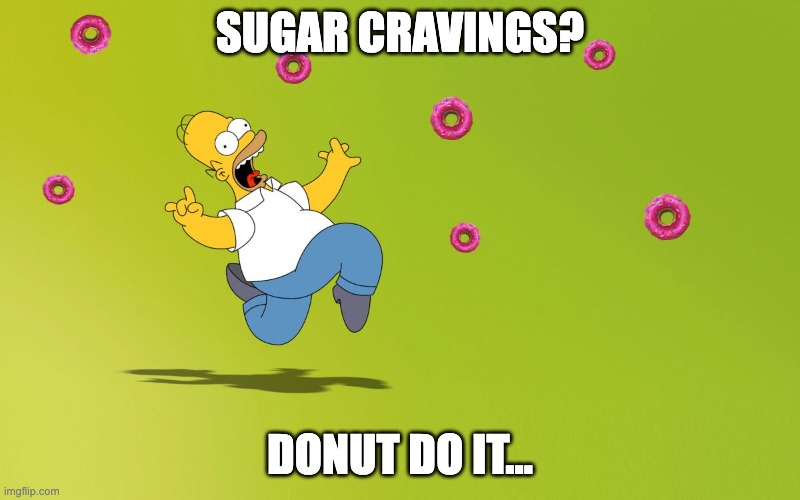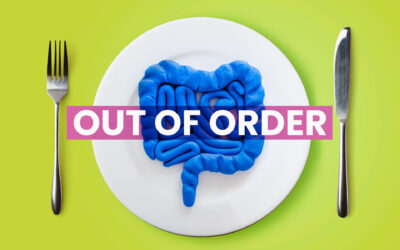Insatiable cravings… all of us have had them at some time or another. Sugar, chocolate, bread….
But why do they hit you out of nowhere? Why is it so hard to overcome cravings?
For a long time, we’ve been led to believe that we make all of our food choices consciously. What if that wasn’t all true?
What if having a healthy gut microbiota may be the key to acting on our food choices consciously?
That’s right. It might not be entirely your poor willpower that is destroying your food choices.
Science is beginning to unearth the evidence to show that our gut microbes play a crucial part in influencing our brain and what and when it desires regarding our food.

How cravings work
It has long been acknowledged that poor mental health is associated with an increased likelihood of eating unhealthy foods (Oliver, Wardle, & Gibson, 2000).
But what about cravings?
You may see cravings as just a sign of weak willpower, but your food preferences are tightly linked to your brain and, in particular, your mental state.
There is a two-way communication pathway between the gut and brain via the vagus nerve. It is called the gut-brain axis. This connection is constantly implicated in research between diet and disease, including mental health conditions such as depression and anxiety.
This relationship starts with what we eat. For a long time, it has been known that what we eat can change the balance of microbes in our digestive tracts. What we consume can increase certain types of bacteria and diminish others – we’ll talk more specifically about that shortly.
As these populations of bacteria change, they secrete different chemicals into our body or activate specific genes in the microbes to send out commands to the rest of the body, including the brain, via the vagus nerve. This is where the microbes have control over our mood.
You may be surprised to know that 50% of dopamine, our pleasure and reward neurotransmitter, and 90% of serotonin, our happiness and stability neurotransmitter, are made in our gut. (Eisenhofer, et al., 1997) (Kim & Camilleri, 2000). These are the same chemicals that are used in powerful antidepressants and anti-anxiety drugs. Apart from some other functions, these neurotransmitters speak directly to the brain.
Both have been shown to directly regulate eating behaviour (Koopman, et al., 2016), and their mood effects are already well established. They are both critical and powerful levers to modify our everyday behaviour and mood.
Where do cravings come from?
There are two predominant ways bacteria send messages to the brain to control our mood and what we eat. Let’s take an overhead look and then drill down how the individual microbiota can influence our mood and body… which is the backdrop for our cravings—the good and bad.
- Microbes can produce toxins and make us feel miserable if we don’t give them what they want. These toxins not only make us feel bad, but they can also send messages straight to the brain to make us think we need that food to survive.
- Microbes can increase our craving for a food they like by changing our tastes buds and producing neurotransmitters such as dopamine and serotonin to make us happy when consumed (this goes for beneficial and harmful bacteria).

The gut microbiota controls hunger
Your body produces different hormones that affect your appetite. These include leptin and ghrelin. It is understood that different bacteria in the gut can affect how much of these hormones are produced and whether they signal you to feel hungry or full (satiated) (Cani, et al., 2009).
Also, short-chain fatty acids are the chemicals produced when certain species of gut bacteria break down fibre. Prebiotic fibre specifically. The bacteria ferment the fibre to feed on it, and they make a chemical that helps suppress appetite and help you feel satiated (Cani, Joly, Horsmans, & Delzenne, 2006).
The make up of your bacteria essentially controls and regulates our digestive hormones and tells us when to feel hungry or full. You are less likely to have cravings when you are feeling satiated.
A decline in the diversity and types of bacteria in our gut is associated with hunger, and the reverse is also true. A diverse microbiota full of beneficial bacteria relates to satiety.
Your gut microbiota has food preferences
Different bacteria prefer different substances. Although many can live off many substances, they usually prefer one over another. For instance, some bacteria prefer sugar over fat. Others are specialists and can only grow if they have a specific macronutrient.
All bacteria require a steady stream of their particular substances to grow and reproduce. They also have their own method of demanding what they want to eat. This is a variation of two basic techniques mentioned above.
A low concentration of the nutrients they require to survive can trigger a survival mechanism where the microbe will start to damage the host, making us feel very average. At other times, the gut microbes secrete proteins that function like hunger-regulating hormones. The bacteria in the gut generate cravings for the substances they thrive on.
That’s right. They can beat us up when we don’t give them what they want.
So, if you have bacteria that thrives on sugar, consuming large amounts of sugar feeds the bacteria that flourish on it. Then the bacteria create more proteins that make you want more sugar so they can keep growing. It is a vicious cycle.
This is why our eating habits may be difficult to change because the microbiota generates cravings for foods they specialise in or those types of foods that will allow them to compete for resources against the other bacteria present (Boulange, Neves, & Chilloux, 2016).
This means that an increased appetite or craving for sugar may be a clear sign that your gut health needs to be balanced. A well-fed, diverse, and balanced microbiota presents a wall of defense to nasty pathogens that attempt to stimulate cravings and intestinal damage.
We have believed that we make our own food choices, and when we make poor ones, it is ultimately our fault. That isn’t entirely true. We should be learning how to manage our gut microbiota before it makes us sick. It’s not only crucial for our gut or general health but our mood.
6 tips to control cravings
Your gut microbiota has a short life cycle and is significantly impacted by what you eat. Certain species thrive, and others don’t survive, depending on what you put in your mouth.
If you feel like you are at the will of your gut health, don’t despair. You can build a healthier microbiota by following a few of these tips.
Knowledge
Despite knowing that the bacteria has such a strong influence on your cravings, it doesn’t give you an excuse to succumb to them. It gives you the ammunition to fight the cravings.
The act of knowing how much our microbiota influences our cravings makes it easier to overcome them.
Diversity
A diverse microbiota is a healthy microbiota. Diversity in your microbiota prevents harmful bacteria from bullying or dominating the beneficial bacteria.
How do you achieve this?
Increase the number of whole foods in your diet. If you need help with this, take a peep here. You may find cravings reducing significantly after you adopt a more nutrient-dense diet over a few months.
Prebiotics
As you know, prebiotics feeds beneficial bacteria. They have been shown to alter emotional processing, induce satiety hormones, and increase the population of beneficial bacteria.
Gut Performance™ is a whole food packed with prebiotics. You can also try onions, garlic, or consuming some resistant starch.
Substitution
This is tough, particularly if you are in the throes of a craving. But it can be done if nothing else is working.
Substitute the food. If you are craving a donut, try some strawberries. Trust us. Once you establish a healthier microbiota, the intensity and regularity of the craving will decrease, and stopping yourself will become easier.
Exercise
Researchers have found that getting out and doing some mild to moderate exercise is enough to enhance the beneficial bacteria composition in your gut. Read this article to get more of the facts.
Fermented foods
Cravings can be easily reduced by increasing the gut microbiota diversity through probiotics. How do we do that? Easy, by throwing some kimchi on your salad, sauerkraut with your protein at night, or even a dollop of natural pot yogurt in your Gut Performance™ smoothie in the morning.
It’s within your power to regulate your cravings. By optimising your gut health through daily doses of Gut Performance – a prebiotic gut health whole food that nourishes your gut microbiome and including diversity to your diet, and adding regular exercise, you can start gaining some control over your cravings.
References
Boulange, C. L., Neves, A. L., & Chilloux, J. (2016). Impact of the gut microbiota on inflammation, obesity, and metabolic disease. Genome Medicine, 8(42). Retrieved 2021, from https://doi.org/10.1186/s13073-016-0303-2
Cani, P. D., Joly, E., Horsmans, Y., & Delzenne, N. M. (2006). Oligofructose promotes satiety in healthy humans: a pilot study. European Journal of clinical nutrition, 60(5), 567-572. Retrieved 2021, from https://doi.org/10.1038/sj.ejcn.1602350
Cani, P. D., Lecourt, E., Dewulf, E. M., Sohet, F. M., Pachikian, B. D., Naslain, D., . . . Delzenne, N. M. (2009). Gut microbiota fermentation of prebiotics increases satietogenic and incretin gut peptide production with consequences for appetite sensation and glucose response after a meal. The American Journal of clinical nutrition, 90(5), 1236-1243. Retrieved 2021, from https://doi.org/10.3945/ajcn.2009.28095
Eisenhofer, G., Aneman, A., Friberg, P., Hooper, D., Fandriks, L., Lonroth, H., . . . Mezey, E. (1997). Substantial production of dopamine in the human gastrointestinal tract. The Journal of clinical endocrinology and metabolism, 82(11), 3864-3871. Retrieved 2021, from https://doi.org/10.1210/jcem.82.11.4339
Kim, D. Y., & Camilleri, M. (2000). Serotonin: a mediator of the brain-gut connection. The American Journal of gastroenterology, 95(10), 2698-2709. Retrieved 2021, from https://doi.org/10.1111/j.1572-0241.2000.03177.x
Koopman, K. E., Roefs, A., Elbers, D. C., Fliers, E., Booij, J., Serlie, M. J., & la Fleur, S. E. (2016). Brain dopamine and serotonin transporter binding are associated with visual attention bias for food in lean men. Psychological medicine, 46(8), 1707-1717. Retrieved 2021, from https://doi.org/10.1017/S0033291716000222
Oliver, G., Wardle, J., & Gibson, E. L. (2000). Stress and food choice: a laboratory study. Psychosomatic medicine, 62(6), 853-865. Retrieved 2021, from https://doi.org/10.1097/00006842-200011000-00016







